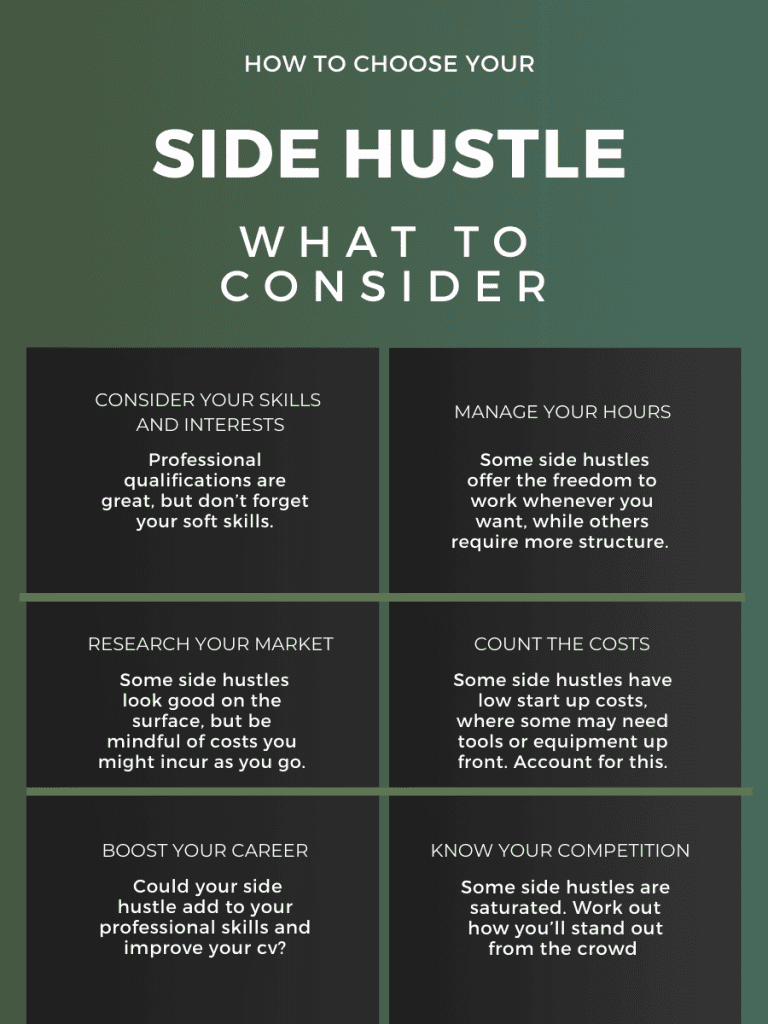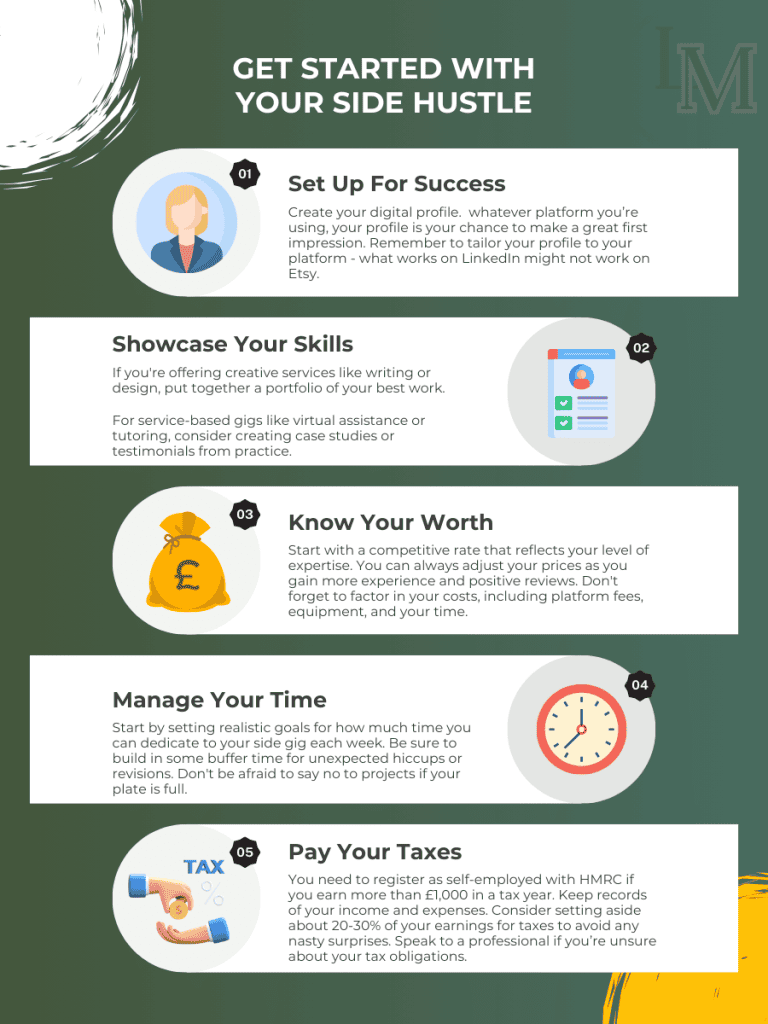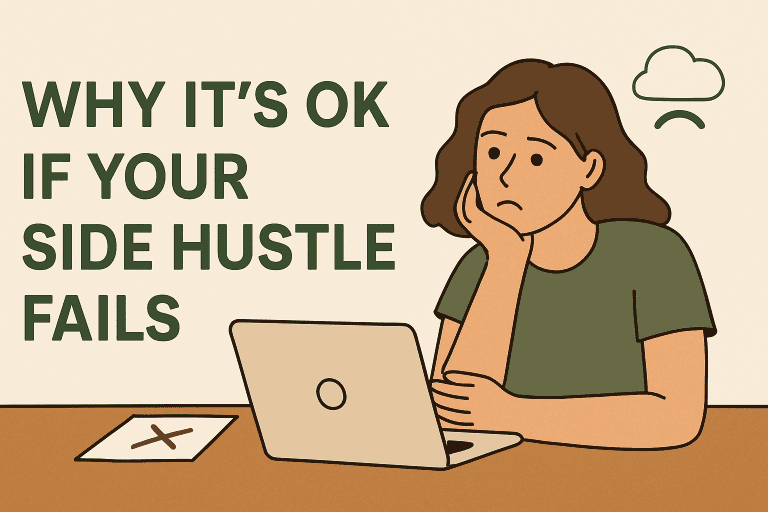Master Gig Economy Side Hustles: Supplement Your Income

So you’d like a little bit on the side? Good – you’re in the right place. Welcome to this guide on gig economy side hustles for 2024.
I love a side hustle too and I’ve had some big successes – Airbnb, flipping properties and dog sitting to name a few. I’ve also had my share of failures – dropshipping can get in the bin, alongside my private hire taxi licence.
That’s not to say dropshipping and driving services aren’t do-able, it’s just that they weren’t a good fit for me at the time I tried them.
In this guide, I’ll help you figure out how to find the gig side hustle that suits you, saving you hours of wasted time and potentially thousands of pounds in cash.
Why Have a Gig Economy Side Hustle
More and more Brits are turning to side gigs to pad their wallets or pursue their passions. Maybe you want to pay off your credit card, build up your savings, or surprise your wife with that golf trip she’s always wanted you to take. Whatever your reasons for wanting to earn a little extra, a side hustle in the gig economy can help you get there.
Did you know that according to recent studies, nearly 40% of UK workers have some form of side hustle? From dog walking to freelance writing, from selling homemade crafts to offering professional services, there’s a lot of opportunity out there.
By the time you’ve finished reading, you’ll be armed with all the knowledge you need to start or improve your side hustle game. Ready? Let’s go!
What is the gig economy?
Well according to the definition, it’s “a labour market characterised by the prevalence of short term contracts or freelance work, as opposed to permanent jobs”.
It’s a temp job. It’s a fancy term for a temp job.
These days, that doesn’t mean filling in for an admin role while the lady who normally does it is off on maternity leave. While that still exists, the emergence of the internet and mobile apps means there’s short term work for everyone, at every skill level.
Let’s take a look at some of the opportunities out there.
Top Gig Side Hustles in 2024
Here’s a look at some of the most popular gig side hustles around today.
Ride-sharing and Food Delivery Services
Fancy yourself a bit of a chauffeur? Companies like Uber, Bolt, and Deliveroo are always on the lookout for drivers. If you’ve got a reliable set of wheels and enjoy being on the road, this could be right up your street. While some drivers report earning £10-20 per hour, it depends heavily on location and demand. Keep in mind that your earnings may fluctuate based on factors like time of day and local events.
Remember to factor in costs like petrol and vehicle maintenance when calculating your potential earnings. It’s also worth noting that some cities require special licences for ride-sharing, so do your homework before jumping in.

Freelance Writing and Content Creation
Got a way with words? The digital world is hungry for content, and businesses are always on the hunt for skilled writers. Platforms like Upwork and PeoplePerHour connect wordsmiths with clients needing everything from blog posts to product descriptions.
Rates vary widely, but experienced writers can earn £30-£100+ per hour. To stand out in this competitive field, consider developing a niche expertise. Whether it’s tech, finance, or lifestyle content, specialising can help you command higher rates and attract repeat clients.
The key here is experience. Having a portfolio to show your clients is expected. If you don’t have one, think about creating one before you set yourself up as a content creator.
I have a portfolio just for this. For me it’s not a main hustle, so I have a document with some example blog posts in different writing styles, social media posts and even a number of product descriptions. I also have some clients who are willing to vouch for me if a prospect needs a reference.
If this is your main focus, consider creating a portfolio website with your body of work to help you stand out.

Virtual Assistance and Online Tutoring
If you’re organised to a fault or have a knack for teaching, these gigs could be your perfect match. Virtual assistants handle tasks like email management, scheduling, and research for busy professionals. Online tutoring platforms let you share your knowledge in subjects you excel in.
Both fields offer flexibility and the chance to work from home. Rates for virtual assistants typically range from £15-£35 per hour, while online tutors can earn £20-£50 per hour, depending on the subject and level of expertise.
Again, it helps to have experience when you’re getting started. If you think Pythagoras is the guy from the Gladiator movie, maybe rethink that maths tutor gig.

Task-based Platforms
Fancy yourself a Jack (or Jill) of all trades? Platforms like TaskRabbit and Airtasker connect you with locals needing help with odd jobs. From furniture assembly to garden tidying, there’s a task for every skill set.
Fiverr is another popular option, ideal for offering digital services like graphic design, voiceover work, or social media management. These platforms let you set your own rates and choose tasks that match your abilities.
If you don’t think you have any useful skills, taskrabbit is a good place to start. There are tasks up for grabs for furniture assembly, TV mounting and putting up shelves – all stuff you could learn to do quickly if you can’t already do it.
If you do possess some digital skills, Fiverr is a good platform. It is competitive though, so some evidence of your work will go a long way to getting your first customers. Like before, your portfolio is your best friend.

Pet-sitting and Dog-walking Services
One for the animal lovers. Apps like Rover and Tailster make it easy to connect with pet owners in your area. You can offer services ranging from daily walks to overnight stays. Many sitters earn £10-£20 per visit or walk, with potential for higher rates during holidays.
This gig combines the joy of spending time with furry friends and the flexibility to set your own schedule. Plus, it’s a fantastic way to stay active and meet new people (and pets) in your community.
I’ve been a pet sitter for years and it’s a great way to earn additional income. Remember, you are looking after a pet that will be considered family to their owners, so this is only right for you if you’re willing to take that responsibility as seriously as it deserves.

Rent Your Stuff
Got a spare room or an unused parking space? There’s probably someone willing to pay for it. Airbnb allows you to rent out a room or entire property to travellers. If you live in a popular area, this can be quite lucrative, especially during peak tourist seasons.
Platforms like JustPark let you rent out your driveway or parking space, which can be particularly profitable if you live near a station, airport, or popular venue. While these options can generate significant passive income, be sure to research local regulations and consider any potential wear and tear on your property.
I used to rent out my apartment on Airbnb when I went away for work, and yes, it can be lucrative. Location matters here, as does your tolerance for having strangers in your space.

How to Choose the Right Gig Side Hustle
When choosing your side hustle, consider your skills, interests, and available time. Some gigs, like ride-sharing, offer immediate earnings but require more active time investment. Others, like rental opportunities, can provide more passive income but may need upfront preparation.
Your Skills and Interests
What are your skills? Do you know? I didn’t until I wrote them down. Qualifications and professional knowledge are great, but don’t forget your soft skills, like time management, problem solving or conflict resolution too. When you know what you’re good at, it will speed up the process of finding a side gig that suits you.
Don’t forget to consider the social aspect of different gigs. Some, like pet-sitting or tutoring, involve plenty of human (or animal) interaction. Others, such as freelance writing or graphic design, might be more solitary. Think about what kind of work environment suits you best.
Time Commitment and Flexibility
Some hustles, like driving for ride-sharing apps, offer the freedom to work whenever you fancy. Others, such as online tutoring, might require more structured time slots. Be honest with yourself about your availability to avoid biting off more than you can chew.
Time commitment is often underestimated. I’ve done this a few times. For instance, I have a private hire taxi licence, but to make it profitable after car hire (my own isn’t suitable), I’d have to work this as a full time job to make it successful. It turns out nobody wants to rent out their car to a guy that wants it for a week when they can easily lease it for 6 months to a year instead.
Earning Potential and Market Demand
Research the going rates for different gigs in your area. Some side hustles might seem lucrative at first glance, but it’s essential to factor in all costs. For instance, food delivery might offer decent hourly rates, but don’t forget to account for petrol and vehicle wear and tear. Also, consider the demand for your chosen service. A saturated market might make it harder to stand out and secure clients.
Startup Costs and Equipment
Don’t overlook startup costs. Some gigs, like virtual assistance, might only need a reliable computer and internet connection. Others could require more significant investment. If you’re thinking about offering gardening services, for example, you’ll need a set of gardening tools to get started. Make sure you’re comfortable with any upfront expenses before diving in.
Matching Side Gigs to Your Long-term Career Goals
Could your side hustle complement your day job or help you transition into a new field? For instance, if you’re eyeing a career in marketing, running social media accounts for local businesses could provide valuable experience. Think about how your chosen gig might look on your CV down the line.

Getting Started with Your Side Gig
So, you’ve chosen your side hustle and you’re ready to get started. Brilliant! There’s a few steps you’ll need to take before you get your first customer. Here’s what to do.
Set Yourself Up for Success
First things first, you’ll need to create your digital shopfront. Whether you’re using Fiverr, Upwork, TaskRabbit, or any other platform, your profile is your chance to make a great first impression.
Start with a clear, professional photo of yourself. No need for a stuffy headshot – a friendly, approachable image will do the trick. Next, craft a compelling bio that highlights your skills and experience. Be specific about what you offer and don’t be shy about tooting your own horn a bit.
Remember to tailor your profile to each platform. What works on LinkedIn might not be the best fit for Etsy. Take the time to understand each platform’s audience and adjust your approach accordingly.
Showcase of Your Skills
Now, let’s show off what you can do. If you’re offering creative services like writing or design, put together a portfolio of your best work. Don’t have any professional examples yet? Create some! Write sample blog posts or design mock-ups to demonstrate your skills. That’s what I did when I started.
For service-based gigs like virtual assistance or tutoring, consider creating case studies or testimonials from practice clients (even if they’re just friends or family). The goal is to give potential clients a clear idea of what you can do for them.
Remember, quality trumps quantity. It’s better to have a handful of stellar examples than dozens of mediocre ones.
Know Your Worth
Pricing can be tricky when you’re first starting out. It’s tempting to undercut the competition, but be careful not to sell yourself short. Research what others in your field are charging and consider your own experience and skills.
Start with a competitive rate that reflects your level of expertise. You can always adjust your prices as you gain more experience and positive reviews. Don’t forget to factor in your costs, including platform fees, equipment, and your time.
Consider offering package deals or tiered pricing to appeal to different client budgets – platforms like Fiverr let you do this. Remember, it’s okay to say no to jobs that don’t meet your minimum rate. Your time and skills are valuable!
Manage Your Time
One of the biggest challenges of side hustling is balancing it with your day job and personal life. Time management is key to avoiding burnout and ensuring you deliver quality work.
Start by setting realistic goals for how much time you can dedicate to your side gig each week. Use tools like Google Calendar or Trello to schedule your tasks and deadlines. Be sure to build in some buffer time for unexpected hiccups or revisions.
Don’t be afraid to say no to projects if your plate is full. It’s better to turn down work than to take on too much and risk disappointing clients or burning yourself out.
Pay Your Taxes
Now for the less exciting but crucial bit – sorting out the legal and financial side of your side hustle. In the UK, you’ll need to register as self-employed with HMRC if you earn more than £1,000 from your side gig in a tax year.
Keep records of your income and expenses. This will make your life much easier when it’s time to file your self-assessment tax return. Consider setting aside about 20-30% of your earnings for taxes to avoid any nasty surprises.
Depending on your gig, you might also need to consider insurance. For example, if you’re offering pet-sitting services, pet business insurance could protect you if anything goes wrong. I have this and it offers peace of mind.
Finally, if you’re not sure about any legal or tax implications, it’s worth consulting with a professional. A small investment in advice now could save you headaches down the road.

Maximising Earnings from Your Gig Side Hustle
So, you’ve got your side hustle up and running. Brilliant! How do you maximise your earnings?
Strategies for Increasing Your Rates Over Time
As you gain experience and build your reputation, it’s only natural that your rates should climb. Start by tracking your hours and calculating your actual hourly rate. If it’s not where you’d like it to be, it’s time for a change.
Gradually increase your prices for new clients. You might be surprised at how many are willing to pay more for quality work. For existing clients, give them a heads up about rate increases well in advance. Explain how your skills have improved and the added value you’re bringing to the table.
Remember, it’s not just about charging more – it’s about providing more value. Can you offer faster turnaround times? More comprehensive services? Think about what sets you apart from the competition.
Upselling and Cross-selling Techniques
Here’s where you can really bump up your earnings. Upselling is about encouraging clients to choose a higher-end service, while cross-selling involves offering additional, complementary services.
For instance, if you’re a freelance writer, you might upsell a client from a basic blog post to a more comprehensive, researched article. Or you could cross-sell by offering social media promotion for the content you’ve written.
The key is to always focus on the value to the client. How will these additional services benefit them? Make it a no-brainer for them to say yes.
Build a Loyal Client Base
Repeat customers are gold dust for any business, and your side hustle is no exception. It’s far easier (and cheaper) to keep existing clients than to constantly find new ones.
Go the extra mile to exceed expectations. Deliver work ahead of schedule, throw in a little something extra, or simply check in to see how they’re doing. These small gestures can make a big difference.
Consider offering loyalty discounts or package deals for repeat customers. And don’t be shy about asking for referrals – word-of-mouth recommendations can be incredibly powerful.
Leverage Reviews and Ratings
In the gig economy, your reputation is everything. Positive reviews and high ratings can set you apart from the competition and justify higher rates.
After completing a job, don’t be afraid to ask satisfied clients for a review. Make it easy for them by providing a direct link to where they can leave feedback.
If you do receive a less-than-stellar review, respond professionally and look for ways to improve. Sometimes, turning a negative experience into a positive one can be even more impressive to potential clients.
Identify Peak Hours and High-Demand Periods
Timing is everything, as they say. Pay attention to when demand for your services is highest. This might be certain times of day, days of the week, or even seasons of the year.
For ride-share drivers, this could mean focusing on rush hour or weekend nights. Freelance writers might find more work around content marketing pushes at the start of each quarter. Virtual assistants could be in high demand during tax season.
Once you’ve identified these peak periods, adjust your availability accordingly. You might be able to charge premium rates during high-demand times.
When I lived alone and travelled for work, I used to rent out my apartment on AirBnb. The difference in demand from one month to the next could be wild depending on what events were happening nearby.
Remember, maximising your earnings isn’t just about working more hours – it’s about working smarter. Keep refining your approach, stay adaptable, and always be on the lookout for new opportunities to add value.
Don’t be afraid to experiment with different strategies. What works brilliantly for one side hustle might not be the best fit for you. The key is to keep learning, adapting, and pushing yourself to new heights.

Balancing Your Side Gig with Your Main Job
You’re probably already busy, so adding a side gig might not be easy. With the right approach, you can make it work without driving yourself round the bend.
Time Management Tips for Juggling Multiple Commitments
You need to get organised. Start by mapping out your weekly schedule, including your main job, side gig, and personal commitments. Look for pockets of time you can dedicate to your side hustle without encroaching on your day job or family time. I do this every Sunday.
Consider using tools like Trello or Asana to keep track of tasks and deadlines. These can be a godsend when you’re trying to keep multiple projects on the go. And don’t forget the humble to-do list – sometimes, old school methods work best.
Try batching similar tasks together. If you’re a freelance writer, for example, you might set aside a chunk of time for research, another for writing, and another for editing. This can help you stay focused and work more efficiently.
Remember, it’s not about finding more time – it’s about making the most of the time you have. Be ruthless about eliminating time-wasters and focus on high-value activities that move your side hustle forward.
Avoid Burnout and Maintain Work-Life Balance
It’s easy to get caught up in the excitement of your side gig and push yourself too hard. But burnout is real, and it can impact both your side hustle and your main job if you’re not careful.
Make sure you’re scheduling in proper downtime. This isn’t just about having a lie-in on Sundays – it’s about giving yourself time to relax, recharge, and do things you enjoy that aren’t work-related.
Listen to your body and mind. If you’re feeling constantly knackered or losing enthusiasm for your side gig, it might be time to take a step back and reassess.
Remember, your side hustle should add to your life, not take over it.
Communicating with Your Primary Employer About Your Side Hustle
This can be a bit of a sticky wicket, but honesty is usually the best policy. Check your employment contract first – some companies have policies about outside work or conflicts of interest.
If you decide to tell your employer, frame it positively. Explain how your side gig is helping you develop skills that could benefit your main job. Reassure them that it won’t interfere with your primary responsibilities.
Be prepared for questions or concerns. Have clear boundaries in mind about when and where you’ll work on your side hustle. And of course, never use company time or resources for your personal business.
Set Boundaries and Know When to Scale Back
Set clear boundaries between your main job, your side gig, and your personal life. This might mean no side hustle work during office hours, or no checking work emails after 8pm. I have an alarm that goes off at 9.30pm every night, that tells me to stop what I’m doing and start my bedtime routine.
Be firm with clients about your availability. It’s okay to say no to rush jobs or weekend work if it’s going to upset your work-life balance. Remember, you’re in control of your side gig – don’t let it control you.
Keep an eye on how your side hustle is affecting your main job performance and your overall wellbeing. If you’re constantly exhausted, missing deadlines, or your relationships are suffering, it might be time to scale back.
Consider setting specific goals for your side gig. Once you’ve hit those targets, reassess whether you want to grow further or maintain your current level. There’s no shame in keeping your side hustle small if that’s what works best for you.
Future-Proofing Your Side Gig
The world is changing, fast. Keeping up is essential if you want to stay ahead.
Stay Updated on Industry Trends
The gig economy is ever-evolving, and what’s hot today might be old hat tomorrow. Make it a habit to regularly read industry blogs, follow thought leaders on social media, and subscribe to relevant newsletters.
Don’t just passively consume information, though. Engage with it. Join online forums or local meetups where you can discuss trends with fellow gig workers. This not only keeps you informed but can also lead to valuable networking opportunities.
Consider setting up Google Alerts for keywords related to your niche. This way, you’ll get notifications about new developments straight to your inbox.
Remember, staying updated isn’t just about knowing what’s new – it’s about understanding how these changes might impact your gig. Always be thinking about how you can adapt and evolve your services to stay relevant.
Diversify Your Gig Portfolio
As the old saying goes, don’t put all your eggs in one basket. Diversifying your gig portfolio can help you weather any storms that might come your way.
Look for complementary skills that you can add to your repertoire. If you’re a freelance writer, for example, you might branch out into proofreading or social media management. This not only makes you more resilient to market changes but also more attractive to potential clients.
Consider expanding into different platforms or markets. If you’ve been focusing solely on local clients, why not dip your toe into the global market? Or if you’ve been relying on one particular gig platform, explore others to spread your risk.
Don’t be afraid to experiment with new types of gigs. You might discover a hidden talent or a lucrative niche you never knew existed. Just be sure to balance experimentation with maintaining your core offering.
Invest in Skill Development and Certifications
In the gig economy, your skills are your currency. Continuously improving and expanding your skill set is one of the best investments you can make in your future.
Look for online courses or workshops that can help you level up your skills. Platforms like Coursera, Udemy, and LinkedIn Learning offer a wealth of affordable options. Many of these even provide certificates upon completion, which can boost your credibility with clients.
Don’t overlook the value of professional certifications in your field. While they might require a bit more time and money upfront, they can significantly increase your earning potential and open doors to higher-paying gigs.
Remember, learning doesn’t always have to be formal. Practice new techniques, experiment with different tools, and challenge yourself to take on projects that push you out of your comfort zone.
Transitioning from Side Hustle to Full-time Entrepreneurship
For some, a side hustle is just the beginning. If you’re dreaming of turning your gig into a full-time business, it’s never too early to start planning.
Start by setting clear financial goals. How much do you need to earn from your gig to replace your current income? Don’t forget to factor in things like healthcare costs and retirement savings that might currently be covered by your main job.
Gradually increase your client base and workload. This might mean sacrificing some free time in the short term, but it’s important to prove to yourself (and potential clients) that you can handle a full-time workload.
Build up an emergency fund to cover at least 3-6 months of expenses. This will give you a financial cushion as you make the transition and navigate the ups and downs of full-time self-employment.
Consider the legal and administrative aspects of running a business. This might include registering your business, setting up proper accounting systems, and securing any necessary insurance or licences.
Remember, the transition doesn’t have to happen overnight. Many successful entrepreneurs start by reducing their hours at their main job or negotiating a part-time arrangement as they build up their side gig.

Conclusion
By using the strategies outlined in this guide, you’ll be well-equipped to find the right side hustle and turn it into an extra source of income.
The key to success lies in choosing the right gig, consistently delivering quality work, and adapting to the ever-changing market demands. Stay flexible, keep learning, and don’t be afraid to pivot when necessary.
Be prepared for a bit of trial and error. It’s not uncommon to try a few different side hustles before finding the perfect fit. Keep an open mind and be willing to pivot if something isn’t working out as you’d hoped.
As your side hustle grows, keep an eye on your work-life balance. It’s exciting to see your earnings increase, but make sure you’re not burning the candle at both ends. After all, the beauty of a side hustle is that it should enhance your life, not take it over.






